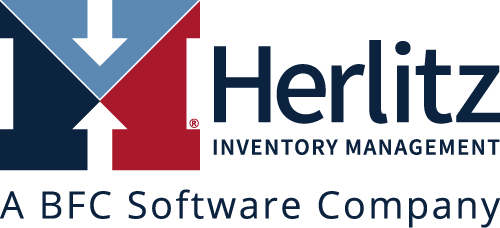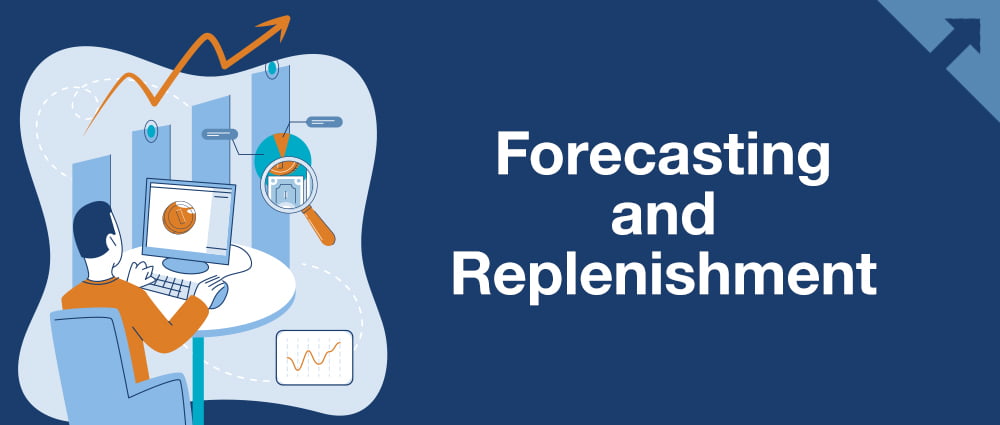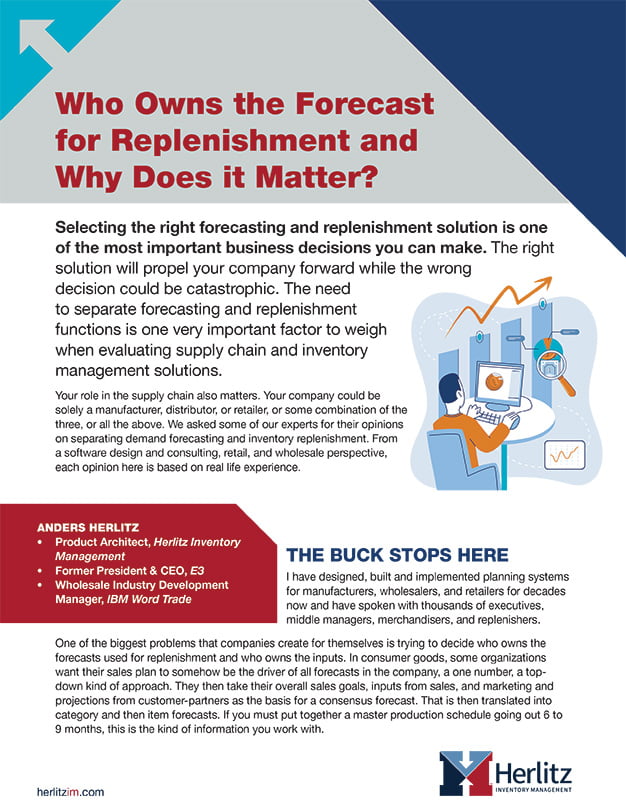Selecting the right forecasting and replenishment solution is one of the most important business decisions you can make. The right solution will propel your company forward while the wrong decision could be catastrophic. The need to separate forecasting and replenishment functions is one very important factor to weigh when evaluating supply chain and inventory management solutions.
Your role in the supply chain also matters. Your company could be solely a manufacturer, distributor, or retailer, or some combination of the three, or all the above. We asked some of our experts for their opinions on separating demand forecasting and inventory replenishment. From a software design and consulting, retail, and wholesale perspective, each opinion here is based on real life experience.
Anders Herlitz
Product Architect, Herlitz Inventory Management
Former President & CEO, E3, Wholesale Industry Development Manager, IBM Word Trade.
The Buck Stops Here
I have designed, built and implemented planning systems for manufacturers, wholesalers, and retailers for decades now and have spoken with thousands of executives, middle managers, merchandisers, and replenishers.
One of the biggest problems that companies create for themselves is trying to decide who owns the forecasts used for replenishment and who owns the inputs. In consumer goods, some organizations want their sales plan to somehow be the driver of all forecasts in the company, a one number, a top-down kind of approach. They then take their overall sales goals, inputs from sales, and marketing and projections from customer-partners as the basis for a consensus forecast. That is then translated into category and then item forecasts. If you must put together a master production schedule going out 6 to 9 months, this is the kind of information you work with.
The problem is that, while this is a comprehensive plan, plans change. Reality then hits and 6 months later the actual production schedule looks quite different. Manufacturing companies have no choice other than to use this process to have the machines, workers, and raw materials in place to build their products. Getting information on actual consumer demand from the retail level translated and synchronized through a 3 or 4-level supply chain is getting closer to reality but is not quite there yet and there will always be a lag.
Retailers and wholesalers have the luxury of being much closer to the real demand signal of the actual consumer. That is why scientific demand forecasting and replenishment were invented – to measure the consumer demand for a specific location and product and respond to it. The demand forecasts determine the future flow of products and is the most critical element to achieving customer service.
For retailers and wholesalers splitting the responsibilities of forecasting and replenishment between two groups voluntarily, within an organization is generally a huge mistake causing inefficiencies and latency that waste time and money. It really is obvious: how can you make the buyer responsible for fill rates and inventory when another group controls the forecasts that drive the replenishment decisions?
If you are a manufacturer managing a few hundred or a few thousand components, you can afford to have a very low ratio of forecasters to items. In other words, in Retail, unless you have a limited number of items (think diamonds, furs or even foodservice), you will not be successful. The reality is that most organizations do not have the resources and intellectual capacity to come up with strong consensus forecasts for tens of thousands of items let alone millions.
Conrad Phillips
Director of Technical Support, Herlitz Inventory Management
Formerly Vice President Planning/Allocation/Replenishment, The Sports Authority, VP Systems Development – E3, and Senior Systems Analyst, Core-Mark
Focus on Communication
For eight years I worked for a sporting goods retailer as VP of Replenishment and Allocation, responsible for all the DC and store ordering. The chain had almost 500 stores nationwide and each store had 30,000 products active at any time, translating into 14 million SKU-locations. We had a centralized replenishment group of 180 that was responsible for store replenishment, assortment planning, and allocation. Each of the replenishers was daily responsible for just over 75,000 SKU-locations.
Sporting goods has a lot of seasonal products. Particularly in sports apparel, as much as 60% of the assortment can change each year and many items were active for only one or two seasons of the year. In an average year, including the product turnover, each replenisher was managing about 200,000K SKU-locations.
Each person was responsible for both the demand forecast and the replenishment of the inventory. I am not saying it was easy, but we achieved 95% in-stock week in and week out plus or minus a half percent. I am still very proud of my team and their performance.
We couldn’t have achieved this without the efficiency of having one person responsible for both the forecast and the replenishment decisions. Since I left, they replaced the system we used successfully for my eight years there with a “more sophisticated system” that split the ownership of the forecast and the replenishment between two groups. One year after implementing the new system the fill rates were averaging below 90 percent and they had increased the number of forecasting and replenishment people to over 800!
It is my understanding that there has been a lot of finger-pointing and unhappy people there. The true measure of unhappiness is that four people have had my job since I left the company and they have cycled through 3 new presidents. In no way am I saying that a replenishment team can do what we did without a sophisticated forecasting and replenishment system. But what this example illustrates is you can fail even with a sophisticated system if you split forecasting from replenishment. Buyers need to own their forecasts and their buying decisions.
One of the other keys to our high service was information flow. Since we had centralized replenishment, we needed to encourage communication from the stores so we would know when local events would occur. A monthly incentive program was created for the replenishers, and each store’s department heads to better communicate on local events and service problems.
Bonuses were paid if they made their goal of 95 percent in-stock for the month. Guess what, over 98 percent of the bonuses were handed out! We had insights to all kinds of local events: parades, marathons, festivals, spring break. We also were familiar with local fishing, hunting, football, and baseball seasons, and unique back to school timing for each store.
With strong communications and having one person responsible for both the forecast and the replenishment decisions, you increase efficiency in performance and manpower. Adding complexities that don’t add value just creates problems.
Note: The Denver Post published an article in 2016 regarding how Sport’s Authority, then the fourth-largest U.S. sporting goods chain, was headed for bankruptcy. It was a reversal of fortune analysts blame on Sports Authority’s staggering debt and the retailer’s failure to adapt to changing consumer tastes.
Outdated information systems, frequent turnover in its leadership and a history of mergers were also to blame for the chain’s bankruptcy, according to a court filing by its CFO, Jeremy Aguilar in 2016.
Marty McHugh
Former Director of Marketing and Customer Onboarding, Herlitz Inventory Management
Former Director of Inventory Planning Systems, ProSource Distribution Services, Senior Purchasing Manager, Martin-Brower
Singular Customer Focus
I spent 15 years working in customized foodservice distribution for quick serve restaurants. Two companies had national and regional distribution programs with the largest 2 burger chains and a select group of other restaurants in the segment.
Having worked with 4 or 5 forecasting and replenishment systems in my career, I have seen forecast maintenance responsibilities held by the replenisher and situations where they were not. Separating responsibilities can work, but it works best in distribution only when:
- There are a limited number of items (less than 500 SKU-locations per forecast analyst).
- The replenishment planning is centralized.
- The overall supply chain is tightly managed from end-to-end.
- Everyone in the company, including suppliers, are hugely focused on customer service.
These companies set an unattainable goal—100 percent service. Anything that was backordered would be re-delivered if the stores needed the product. Air freight, messenger service, and all other means were used to get the products delivered. Purchasing fill rates averaged as high as 99.96 percent. That is 4 backorders out of 10,000 cases ordered. When you fell below 99.80 in that environment, you were having a very bad week.
As in Conrad’s sporting goods example, the organization was structured and focused on providing excellent service. There was a continuing emphasis on teamwork and communications. To motivate this high level of performance, the forecast analysts and buyers had bonus incentives based on forecast accuracy, service levels, and inventory turns.
In this environment, with a limited number of products, having forecast analysts and replenishment buyer functions separated worked well. This is because the company recognized:
- The complexity of the solution – IBM’s INFOREM. It required trained forecast analysts reviewing forecast exceptions with replenishers and updating the item demand history. INFOREM was designed before there was something called a “user interface.” Doing 1980’s style maintenance is not a pretty thing and is a burn on resources.
- The company understood the costs associated with forecasting problems, unhappy customers, and increased logistics costs, and was willing to devote resources to fixing them.
This structure worked in customized food distribution because the cost of non-compliance (a problem) was way too high. Fixing a service problem might cost thousands of dollars. Fixing the cause of a potential problem in the forecast before you were out of stock was smart business. When you only have one customer you need to keep them happy!
When you are evaluating supply chain software and structure for your company, we would recommend looking at the complexity of the solution vs your business goals. Will the solution deliver the results your customers expect at a price you can afford, both in terms of people and inventory investment? Some solutions provide functionality but at a significantly higher price, both in terms of personnel and the inventory required to deliver to your service goals.
Regardless of whether your company is a manufacturer, distributor, or retailer, your margins, customer service, turns goals, and the number of SKUs, all need to be weighed when looking to make a change. The level of functionality and the complexity of software varies greatly. This can have a huge effect on your business results, affecting both customer service and profitability. Finding a solution that matches the characteristics of your business and provides simple but sophisticated functionality for your team should be your goal.


